How to Plan a Cottage Garden: From Sweet Peas to Hollyhocks
A cottage garden is a charming, whimsical space overflowing with flowers, rich textures, and a sense of unrestrained beauty. Unlike formal gardens with precise symmetry, a cottage garden embraces an informal, abundant planting style, often featuring classic flowers like sweet peas, hollyhocks, delphiniums, and foxgloves. Whether you’re starting from scratch or refining an existing space, this guide will walk you through everything you need to know about planning a romantic, flower-filled cottage garden.
hollyhocks, delphiniums, and foxgloves. Whether you’re starting from scratch or refining an existing space, this guide will walk you through everything you need to know about planning a romantic, flower-filled cottage garden.
Step 1: Choosing the Right Location
A successful cottage garden starts with selecting the ideal location. Most traditional cottage garden plants thrive in full sun, needing at least 6-8 hours of direct sunlight per day. However, if you have a partially shaded area, you can still achieve the look by incorporating shade-tolerant plants like foxgloves, hellebores, and columbines.
Soil quality is also essential—rich, well-draining soil will support a diverse mix of flowers. If your soil is heavy clay or sandy, amend it with organic matter like compost or aged manure to improve its structure and fertility.
Step 2: Designing the Layout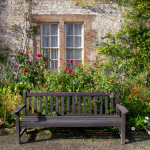
Cottage gardens are known for their informal, overflowing look, but they still require thoughtful planning. Consider the following elements when designing your layout:
1. Layering for Height and Depth
A well-planned cottage garden has a sense of verticality, with plants arranged by height:
- Tall flowers (4-8 feet): Hollyhocks, foxgloves, delphiniums, and sunflowers create a dramatic backdrop.
- Medium-height plants (2-4 feet): Phlox, roses, daisies, and salvias add fullness and color.
- Low-growing plants (under 2 feet): Sweet peas, violets, alyssum, and creeping thyme fill in gaps and soften borders.
Planting in clusters or drifts rather than single rows creates a more naturalistic look.
2. Pathways and Structures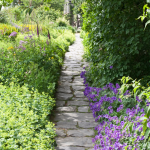
Incorporating meandering pathways made of gravel, stepping stones, or brick enhances the romantic charm of a cottage garden. Arches, trellises, and obelisks provide support for climbing plants like sweet peas, clematis, and roses, adding vertical interest.
3. Mixing Flowers and Edibles
Traditionally, cottage gardens combined flowers, herbs, and vegetables. You can integrate edibles like lavender, chives, thyme, strawberries, and even tomatoes for both beauty and function.
Step 3: Choosing the Right Plants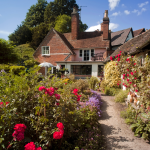
A well-balanced cottage garden includes a mix of annuals, perennials, biennials, and climbers to ensure continuous blooms throughout the growing season.
1. Classic Cottage Garden Flowers
- Sweet Peas (Lathyrus odoratus) – These fragrant climbers bloom profusely in spring and early summer, ideal for trellises and archways.
- Hollyhocks (Alcea rosea) – Towering spires of large, colorful flowers that add vertical drama.
- Foxgloves (Digitalis purpurea) – Bell-shaped blooms loved by pollinators, perfect for shady spots.
- Delphiniums – Vibrant blue and purple spikes that provide striking color.
- Peonies – Lush, romantic blooms that return year after year.
- Roses – Classic shrub or climbing varieties like David Austin roses work beautifully.
- Daisies (Leucanthemum spp.) – Simple, cheerful flowers that add a meadow-like feel.
2. Fragrant and Pollinator-Friendly Choices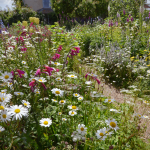
- Lavender – Aromatic and perfect for edging paths.
- Phlox – Fragrant clusters of summer flowers in shades of pink, white, and purple.
- Bee Balm (Monarda) – Attracts hummingbirds and adds a pop of color.
- Catmint (Nepeta) – A lavender-like plant that bees and butterflies adore.
3. Filler and Ground Cover Plants
- Alyssum – A low-growing plant that spills over borders with tiny, fragrant blooms.
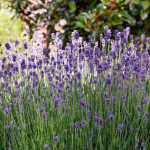
- Creeping Thyme – Great for softening the edges of paths.
- Violas and Pansies – Early bloomers that add cheer in spring and fall.
Step 4: Planting and Maintenance
1. When and How to Plant
- Perennials and shrubs should be planted in early spring or fall to allow root establishment.
- Annuals like sweet peas can be direct sown in early spring after the last frost.
- Biennials like foxgloves and hollyhocks need to be started one year in advance for blooms the following season.
2. Watering and Fertilizing
- Water deeply but infrequently, aiming for about 1 inch per week.
- Mulch around plants to retain moisture and suppress weeds.
- Use organic fertilizers like compost tea or fish emulsion to keep plants thriving.
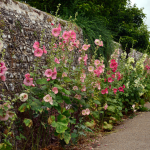
3. Pruning and Deadheading
Regular deadheading (removing spent flowers) encourages more blooms. Some perennials, like delphiniums and phlox, can be cut back after blooming to encourage a second flush of flowers.
Step 5: Adding Finishing Touches
1. Garden Ornaments and Accessories
A true cottage garden embraces charm and whimsy. Consider adding:
- Birdbaths and birdhouses to attract wildlife.
- Rustic wooden benches nestled among flowers.
- Vintage containers and wheelbarrows planted with blooms.
2. Seasonal Interest
Extend the garden’s appeal by adding elements for every season:
- Spring: Daffodils, tulips, and primroses.

- Summer: Roses, hollyhocks, and sweet peas.
- Fall: Asters, sedum, and ornamental grasses.
- Winter: Evergreens, hellebores, and dried seed heads for structure.
Conclusion
Planning a cottage garden is as much about embracing creativity and spontaneity as it is about structure. By layering plants, incorporating romantic climbers, and mixing perennials with annuals, you’ll create a timeless, enchanting retreatfilled with beauty year after year. Whether you’re drawn to the fragrance of sweet peas or the towering presence of hollyhocks, your cottage garden will be a place of joy, relaxation, and natural splendor.
Now, grab your spade and start planting—your dream cottage garden awaits!
I






